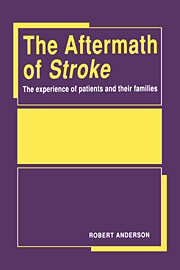Book contents
- Frontmatter
- Contents
- Acknowledgements
- Chapter 1 Stroke: An introduction to the problem
- Chapter 2 The Greenwich stroke study
- Chapter 3 Coming into medical care: the first month after stroke
- Chapter 4 Hospital care and rehabilitation
- Chapter 5 Survival, physical disability and health
- Chapter 6 Support in the community
- Chapter 7 The effects of stroke on social, family and personal life
- Chapter 8 Caring and coping with stroke
- Chapter 9 Resources for coping with stroke
- Appendix: Measurement and scoring of variables
- References
- Index
Chapter 7 - The effects of stroke on social, family and personal life
Published online by Cambridge University Press: 07 October 2011
- Frontmatter
- Contents
- Acknowledgements
- Chapter 1 Stroke: An introduction to the problem
- Chapter 2 The Greenwich stroke study
- Chapter 3 Coming into medical care: the first month after stroke
- Chapter 4 Hospital care and rehabilitation
- Chapter 5 Survival, physical disability and health
- Chapter 6 Support in the community
- Chapter 7 The effects of stroke on social, family and personal life
- Chapter 8 Caring and coping with stroke
- Chapter 9 Resources for coping with stroke
- Appendix: Measurement and scoring of variables
- References
- Index
Summary
The recognition and treatment of the emotional and social consequences of stroke is both difficult and important. These aspects have been sadly neglected although they probably constitute the most problematic elements in rehabilitation, and cause most distress to the patient's family. As Newman (1984) has indicated, those concerned with the processes of recovery and rehabilitation need to look at both the family and the wider social context if they are to be successful at reintegrating stroke patients in the community. The emphasis in everyday life is upon the handicap resulting from the stroke, and that is the focus of this chapter. In particular, the analyses will concentrate on aspects of change following the stroke – in social and domestic activities, mood and emotions, family relationships and specifically the relationship between the patient and supporter.
Housework
Before the stroke, five-sixths of the patients were doing some housework, but this is one activity that most reduce without discrimination by sex or age. Altogether four-fifths of patients were doing less than they had before the stroke. The pattern of changes in scores for housework activities before and after the stroke is shown in Table 49, which demonstrates that most of the reduction has occurred by 9 months after the stroke. Among survivors to 18 months after stroke, the average scores for housework (see Appendix) fell from 16.3 before the stroke to 12.0 at 9 months and to 10.9 at 18 months.
- Type
- Chapter
- Information
- The Aftermath of StrokeThe Experience of Patients and their Families, pp. 144 - 178Publisher: Cambridge University PressPrint publication year: 1992



